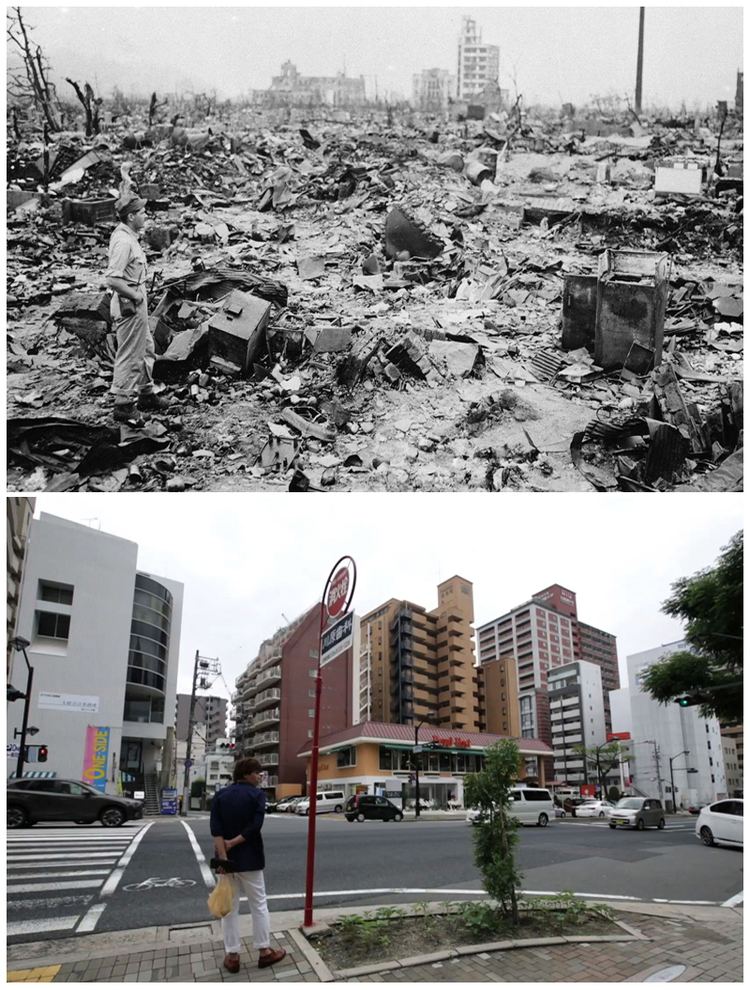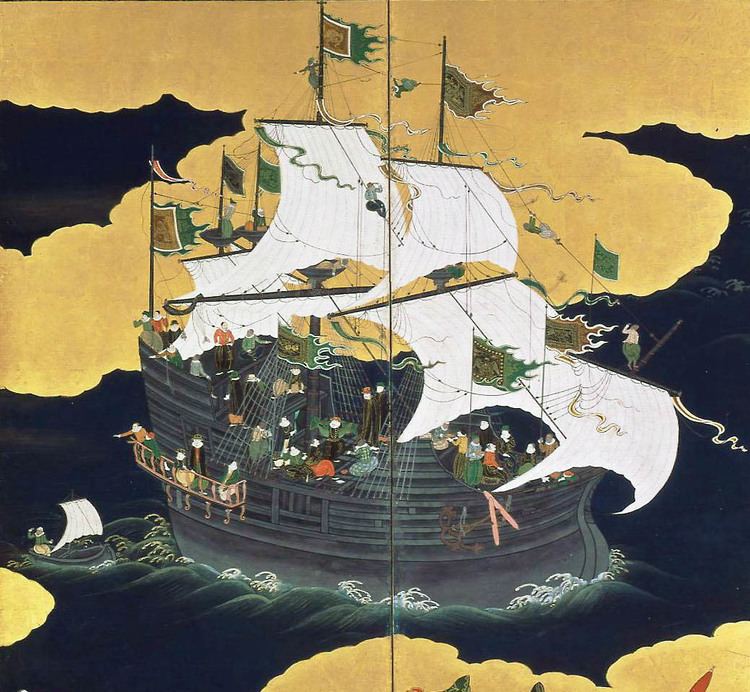Area 406.35 km2 | Region Mayor Tomihisa Taue (2007-) Population 443,766 (2010) | |
 Points of interest Colleges and Universities Nagasaki University, Nagasaki Junshin Catholic University, Kwassui Womens University, Nagasaki University of Foreign Studies, Nagasaki Institute of Applied Science | ||
Nagasaki ( Nagasaki-shi) is the capital and the largest city of Nagasaki Prefecture on the island of Kyushu in Japan. It became a center of Portuguese and other European influence in the 16th through 19th centuries, and the Churches and Christian Sites in Nagasaki have been proposed for inscription on the UNESCO World Heritage List. Part of Nagasaki was home to a major Imperial Japanese Navy base during the First Sino-Japanese War and Russo-Japanese War. Its name means "long cape".
Contents
- Map of Nagasaki
- Japans historical sites dejima island nagasaki japan as it truly is
- Holidays to nagasaki
- History
- Geography and climate
- Cuisine
- References
Map of Nagasaki
During World War II, the atomic bombings of Hiroshima and Nagasaki made Nagasaki the second and, to date, last city in the world to experience a nuclear attack.
Japans historical sites dejima island nagasaki japan as it truly is
As of January 1, 2009, the city has an estimated population of 446,007 and a population density of 1,100 persons per km². The total area is 406.35 km².
Holidays to nagasaki
History

A small fishing village secluded by harbours, Nagasaki had little historical significance until contact with Portuguese explorers in 1543. An early visitor was Fernão Mendes Pinto, who came on a Portuguese ship which landed nearby in Tanegashima.

Soon after Portuguese ships started sailing to Japan as regular trade freighters, thus increasing the contact and trade relations between Japan and the rest of the world, and particularly with mainland China, with whom Japan had previously severed its commercial and political ties, mainly due to a number of incidents involving Wokou piracy in the South China Sea, with the Portuguese now serving as intermediaries between the two Asian countries. Despite the mutual advantages derived from these trading contacts, which would soon be acknowledged by all parties involved, the lack of a proper seaport in Ky?sh? for the purpose of harboring foreign ships posed a major problem for both merchants and the Kyushu daimyo (feudal lords) who expected to collect great advantages from these intercourse with the Portuguese.
In the meantime, Navarrese Jesuit missionary St. Francis Xavier arrived in Kagoshima, South Ky?sh?, in 1549, and soon initiated a thorough campaign of evangelization throughout Japan, but left for China in 1551 and died soon afterwards. His followers who remained behind converted a number of daimyo. The most notable among them was ?mura Sumitada, who greatly profited from his conversion to the "Kirishitan" religion through an accompanying deal to receive a portion of the trade from Portuguese ships. In 1569, ?mura granted a permit for the establishment of a port with the purpose of harboring Portuguese ships in Nagasaki, which was finally set in 1571, under the supervision of the Jesuit missionary Gaspar Vilela and Portuguese Captain-Major Tristão Vaz de Veiga, with ?muras personal assistance.
The little harbor village quickly grew into a diverse port city, and Portuguese products imported through Nagasaki (such as tobacco, bread, textiles and a Portuguese sponge-cake called castellas) were assimilated into popular Japanese culture. Tempura derived from a popular Portuguese recipe originally known as peixinho-da-horta, and takes its name from the Portuguese word, tempero another example of the enduring effects of this cultural exchange. The Portuguese also brought with them many goods from China.
Due to the instability during the Sengoku period, Sumitada and Jesuit leader Alexandro Valignano conceived a plan to pass administrative control over to the Society of Jesus rather than see the Catholic city taken over by a non-Catholic daimyo. Thus, for a brief period after 1580, the city of Nagasaki was a Jesuit colony, under their administrative and military control. It became a refuge for Christians escaping maltreatment in other regions of Japan. In 1587, however, Toyotomi Hideyoshis campaign to unify the country arrived in Ky?sh?. Concerned with the large Christian influence in southern Japan, as well as the active and what was perceived as the arrogant role the Jesuits were playing in the Japanese political arena, Hideyoshi ordered the expulsion of all missionaries, and placed the city under his direct control. However, the expulsion order went largely unenforced, and the fact remained that most of Nagasakis population remained openly practicing Catholic.
In 1596, the Spanish ship San Felipe was wrecked off the coast of Shikoku, and Hideyoshi learned from its pilot that the Spanish Franciscans were the vanguard of an Iberian invasion of Japan. In response, Hideyoshi ordered the crucifixions of twenty-six Catholics in Nagasaki on February 5 of that year (i.e. the "Twenty-six Martyrs of Japan"). Portuguese traders were not ostracized, however, and so the city continued to thrive.
In 1602, Augustinian missionaries also arrived in Japan, and when Tokugawa Ieyasu took power in 1603, Catholicism was still tolerated. Many Catholic daimyo had been critical allies at the Battle of Sekigahara, and the Tokugawa position was not strong enough to move against them. Once Osaka Castle had been taken and Toyotomi Hideyoshis offspring killed, though, the Tokugawa dominance was assured. In addition, the Dutch and English presence allowed trade without religious strings attached. Thus, in 1614, Catholicism was officially banned and all missionaries ordered to leave. Most Catholic daimyo apostatized, and forced their subjects to do so, although a few would not renounce the religion and left the country for Macau, Luzon and Japantowns in Southeast Asia. A brutal campaign of persecution followed, with thousands of converts across Ky?sh? and other parts of Japan killed, tortured, or forced to renounce their religion.
Catholicisms last gasp as an open religion, and the last major military action in Japan until the Meiji Restoration, was the Shimabara Rebellion of 1637. While there is no evidence that Europeans directly incited the rebellion, Shimabara Domain had been a Christian han for several decades, and the rebels adopted many Portuguese motifs and Christian icons. Consequently, in Tokugawa society the word "Shimabara" solidified the connection between Christianity and disloyalty, constantly used again and again in Tokugawa propaganda.
The Shimabara Rebellion also convinced many policy-makers that foreign influences were more trouble than they were worth, leading to the national isolation policy. The Portuguese, who had been previously living on a specially constructed island-prison in Nagasaki harbour called Dejima, were expelled from the archipelago altogether, and the Dutch were moved from their base at Hirado into the trading island. In 1720 the ban on Dutch books was lifted, causing hundreds of scholars to flood into Nagasaki to study European science and art. Consequently, Nagasaki became a major center of rangaku, or "Dutch Learning". During the Edo period, the Tokugawa shogunate governed the city, appointing a hatamoto, the Nagasaki bugy?, as its chief administrator.
Consensus among historians was once that Nagasaki was Japans only window on the world during its time as a closed country in the Tokugawa era. However, nowadays it is generally accepted that this was not the case, since Japan interacted and traded with the Ry?ky? Kingdom, Korea and Russia through Satsuma, Tsushima and Matsumae respectively. Nevertheless, Nagasaki was depicted in contemporary art and literature as a cosmopolitan port brimming with exotic curiosities from the Western World.
In 1808, during the Napoleonic Wars the Royal Navy frigate HMS Phaeton entered Nagasaki Harbor in search of Dutch trading ships. The local magistrate was unable to resist the British demand for food, fuel, and water, later committing seppuku as a result. Laws were passed in the wake of this incident strengthening coastal defenses, threatening death to intruding foreigners, and prompting the training of English and Russian translators.
The T?jinyashiki or Chinese Factory in Nagasaki was also an important conduit for Chinese goods and information for the Japanese market. Various colourful Chinese merchants and artists sailed between the Chinese mainland and Nagasaki. Some actually combined the roles of merchant and artist such as 18th century Yi Hai. It is believed that as much as one-third of the population of Nagasaki at this time may have been Chinese.
Geography and climate
Nagasaki and Nishisonogi Peninsulas are located within the city limits. The city is surrounded by the cities of Isahaya and Saikai, and the towns of Togitsu and Nagayo in Nishisonogi District.

Nagasaki lies at the head of a long bay which forms the best natural harbor on the island of Ky?sh?. The main commercial and residential area of the city lies on a small plain near the end of the bay. Two rivers divided by a mountain spur form the two main valleys in which the city lies. The heavily built-up area of the city is confined by the terrain to less than 4 square miles (10 km2).
Nagasaki has the typical humid subtropical climate of Ky?sh? and Honsh?, characterized by mild winters and long, hot, and humid summers. Apart from Kanazawa and Shizuoka it is the wettest sizeable city in Japan and indeed all of temperate Eurasia. In the summer, the combination of persistent heat and high humidity results in unpleasant conditions, with wet-bulb temperatures sometimes reaching 26 °C (79 °F). In the winter, however, Nagasaki is drier and sunnier than Got? to the west, and temperatures are slightly milder than further inland in Ky?sh?. Since records began in 1878 the wettest month has been July 1982 with 1,178 millimetres (46 in) including 555 millimetres (21.9 in) in a single day, whilst the driest month has been September 1967 with 1.8 millimetres (0.07 in). Precipitation occurs year-round, though winter is the driest season; rainfall peaks sharply in June & July. August is the warmest month of the year.
